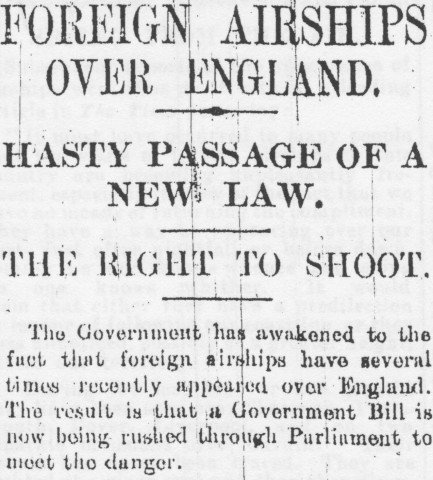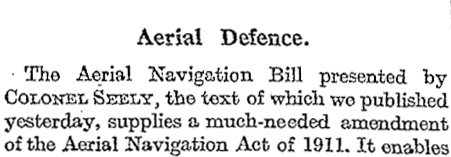
Today is another big day for phantom airships in terms of press coverage. They are mentioned in at least four big London dailies as well as two major and three minor provincial dailies. The reason is yet another airship report from South Wales, where it was seen by many people last people. How many? Well, 'thousands', according to the Daily Express (p. 5) and the Standard (p. 8); 'large numbers', according the Daily Mail (p. 3); 'Many', according to the Manchester Guardian; and 'Numerous', according to The Times (p. 12), the Edinburgh Scotsman, the Dundee Courier (okay -- 'numerous'; p. 4), and the Manchester Courier (p. 7). Whatever the precise figure, it would appear to be a dramatic increase over the numbers of witnesses previously involved. But that then makes the failure of any of the newspaper reports to name a witness or provide a detailed account all the more frustrating.
Most of the articles are identical or nearly identical to this paragraph which appeared in The Times (p. 12):
It is again reported that an airship has been seen in South Wales. Numerous observers at Newport, Cardiff, Neath, and intermediate places stated last night [5 February 1913] that they observed a dirigible, carrying a bright light, pass overhead and some spectators, including a police sergeant, declared that the outline of the vessel was clearly visible. The night was bright with very little wind. The supposed airship took a north-westerly course.
The Dundee Courier is one of the newspapers which reprints this same report nearly word for word; but it is also the only newspaper out of all of them to actually give a time: the airship 'appeared shortly after eight o'clock' (p. 4). Some further details can be extracted by comparing the other accounts on offer: This is the Mail's (p. 3):
An airship is reported to have been seen by large numbers of people at Cardiff, Newport (Monmouthshire), and Neath last night. At Newport what was thought to be an airship with a light appeared to remain stationary over a spot a few miles from the town for more than an hour.
Although according to the Liverpool Echo, the Newport airship 'remained in the neighbour hood for nearly two hours' (p. 4). The Standard has some information on the order of the sightings (p. 8):
A sensation was caused in South Wales last night, says the Central News correspondent, by the appearance of what is supposed to have been a dirigible airship travelling over the Bristol Channel. The airship followed the course of the Channel from Newport to Neath, and at the latter place was lost sight of. The craft, which is supposed to be the same mysterious airship concerning which there has lately been so much speculation, was carrying a great headlight, and was seen by thousands of people.
But reconstructing the story in this way is a fraught process. It would be more helpful to have a smaller number of more detailed accounts.
The Express also has an airship report from suburban London. It's also sketchy but it does provide the eyewitness's name (p. 5):
Mr. Phelps, of Collindale-avenue, Hendon, states that he saw an airship flying over the London Aerodrome at 7.20 p.m. last night [5 February 1913]. The airship was going in the direction of Farnborough.
At least an aerodrome is an appropriate place for an airship!
The Guardian makes up for all these vague stories with a detailed one about a local airship sighting, in South Manchester:
Mr. Marshall, of Dudley Avenue, Whalley Range, explained to a 'Manchester Guardian' representative that he and several of his family first noticed the light at about 6 30 last evening [5 February 1913], and watched it from the garden of his house for a matter of twenty-five minutes. Nothing was visible, he said, except a brilliant light at an altitude which he estimated at about 900 feet. It appeared to be moving over Chorlton. From 6 30 to 6 40 its movement was rapid and in the direction of the north. For the rest of the time that it was under observation its movement was very slow, though still in a northerly direction, and it swayed a little as if the airship supporting it was being buffeted by the wind. During this period the light was switched out twice, reappearing, with equal brilliance, after an interval of about a minute. The light itself was all directed downwards, but its exact angle seemed to be varied several times. When the light disappeared for the last time it had still been moving towards the north.
Marshall is clearly a careful observer, though perhaps someone could explain to him that thanks to trigonometry you can't really estimate the distance of a distant object unless you know how big it is; and you can't know how big it is unless you know what it is.
Finally, the Mail offers this thought in relation to the South Wales mystery airship, though perhaps it could apply to the others as well:
It is suggested that the light was really the brilliant planet Venus, now an evening star.
Could it really be that simple?
![]() This work is licensed under a Creative Commons Attribution-NonCommercial-NoDerivatives 4.0 International License.
Permissions beyond the scope of this license may be available at http://airminded.org/copyright/.
This work is licensed under a Creative Commons Attribution-NonCommercial-NoDerivatives 4.0 International License.
Permissions beyond the scope of this license may be available at http://airminded.org/copyright/.





Pingback:
Friday, 7 February 1913
Brett Holman
Post authorThe 'Mr. Phelps, of Collindale-avenue, Hendon' who saw an airship over London Aerodrome may have been a pilot himself, or at least a pupil. There are a number of references in Flight from around this time to a man of that name who flew machines belonging to the British Deperdussin School at London Aerodrome (the address of which was Collindale Avenue, Hendon). For example the issue of 4 January says of Deperdussin No. 2 that 'Mr. Phelps was also practising on the same machine, showing some improvement.' On 8 February it was reported that he did 'straights on No. 3'. It doesn't sound like he was very advanced, and earlier issues indicate that he was a pupil. Perhaps that's why the Express doesn't mention his aeronautical expertise, which still must have far exceeded that of most people who saw scareships. Or maybe it's just a coincidence.
Pingback:
Saturday, 8 March 1913
Pingback:
Wednesday, 9 April 1913
Pingback:
Mapping the 1913 phantom airship scare